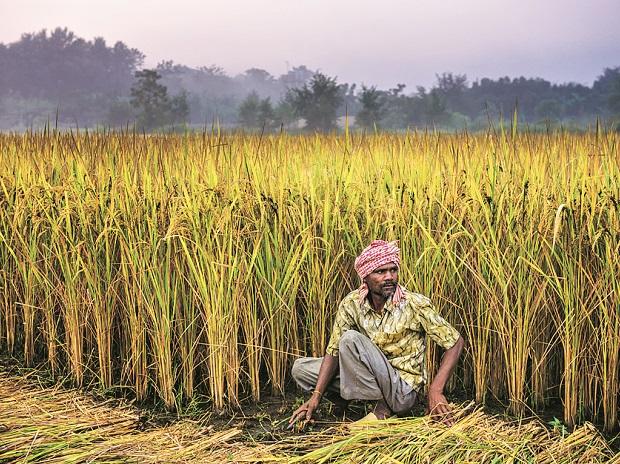https://www.business-standard.com/article/economy-policy/agricultural-issues-and-challenges-in-andhra-pradesh-during-2004-to-2014-118122900494_1.html Download the paper 2014 White Paper on Agriculture Department
Continuous dependence on old varieties has pushed the farmers into a tough situation of stagnant yields and increasing cost, ultimately cutting into their income

During the decade of 2004 to 2014 the agriculture in united AP faced number of problems and farmers suffered due to declining crop yields, widening yield gaps in comparison with best yields in the country, increasing prices of agriculture inputs resulting in increased cost of cultivation and changes associated with climate variability.
Major problems noticed during this period were:
Cost of cultivation: The cost of cultivation registered steep increase in this period thus affecting the net income of the farmers. Due to low farm income, the financial condition of the farmers got worse leaving them in an unending cycle of indebtedness and adversity.
Inflation: Over the years the rate of inflation was 4.43 in 2005-06, 6.59 in 2006-07, 4.74 in 2007-08, 8.05 in 2008-09, 3.80 in 2009-10, 9.56 in 2010-11, 8.94 in 2011-12, 7.36 in 2012-13 and 5.98 in 2013-14. Consequently, the real income of the farmer has come down drastically due to increase in labour cost and inflationary pressures on prices of inputs and other consumer items which farmer buys.
Low and stagnant productivity: During this period the area and yield of crops like paddy, pulses remained stagnant and in oilseeds there was decline. The yield levels in comparison with other States, showed gaps in all crops except in maize. In crops like rice, redgram, groundnut, sunflower, castor the wide gap between the yield of AP State and the highest yielding State in the country was observed. Though there is possible potential for enhancement of productivity in the State and highlights the failure of Government initiated programmes including the research initiatives of the university.
Research efforts have not been successful in developing varieties which are viable in the field. Continuous dependence on old varieties has pushed the farmers into a tough situation of stagnant yields and increasing cost, ultimately cutting into their income.
Failure of extension system: Adarsha rythus were introduced in the year 2007 to provide interface between farmers and extension staff of agriculture and allied departments for dissemination of technology and other activities. There is no tangible contribution of Adarsha rythus in extension work, though the Government spent Rs.28 crores approximately every year. It is felt that most of the Adarsha rythus were non practicing farmers and were not qualified or not having requisite knowledge to sensitize the farmers.
Soil Health Management: Soil health management was not given due importance which resulted in land degradation and excess use of chemical fertilizers thereby disturbing the nutrient imbalance in the soil and crop growth. The saline and alkali soils where productivity and income to farmers was very low have not been addressed.
Indiscriminate use of fertilizers led to imbalance in soil fertility and increase in input cost resulting into not only non availability of micronutrients but also resulted in yield losses.
Fertilizer crisis in 2008-09 & price rise in DAP and other complexes: During 2008-09, timely action was not taken for indenting and positioning of fertilizers. The delay in supply of fertilizers like DAP and other complexes resulted in long queues of farmers at sale points causing unrest among the farming community and law and order problem.
In the years 2011-12 and 2012-13, there was steep rise in price of DAP (from Rs.485/- in 2009 to Rs.1193/- in 2013) and other complex fertilizers (Rs.362/- in 2008 to Rs. 1155/- in 2013) and as a result the cost of cultivation has gone up substantially.
Due to increase in the cost of complex fertilizers, the farmers opted for excessive use of urea which resulted in crisis of fertilizers and also in increase of cost cultivation.
Cloud seeding: Cloud seeding operations were conducted by the government from 2004 to 2009 at a cost of Rs. 127.10 crores in united state of Andhra Pradesh.
During 2005 and 2006 ten districts were covered in each year and from 2007 to 2009 twelve districts were covered in each year. Though the programme was intended to induce rain by using technology of cloud seeding there is no effective evidence to show that it really induced rains and benefitted the farmers.
Impact of bifurcation of Andhra Pradesh state on newly formed Andhra Pradesh in agriculture sector:
Agricultural education, research and extension: In united Andhra Pradesh there is one Agricultural University, located in Hyderabad and presently it is in Telangana state. So, the important laboratories like DNA Finger Printing, Tissue culture, NMR Oil analysis are in Telangana state. Colleges and Research Stations, based on the location, are allotted to respective States.Department of Agriculture: The DNA finger printing & transgenic crops monitoring laboratory, Bio-pesticides quality control laboratory and pesticide residue testing laboratory are in Hyderabad and are allotted to Telangana State. No such facilities are available in A.P. The Apex agriculture training institute SAMETI is also allotted to Telangana state. It takes considerable time and expenditure to develop such facilities in A.P.
Seed industry: There are 969 private seed processing units in Telangana as against 309 in Andhra Pradesh. As a result, the capacity of seed processing facility and supply are affected adversely in the State of Andhra Pradesh.
The vision of the Government is to become:
One of the top three developed States in India by 2022, No.1 State in India by 2029 and one of the states with highest standard in the world by 2050.
Edited excerpts from the White Paper on Agriculture in Andhra Pradesh, issued by Chief Minister N Chandrababu Naidu on December 26 in Amaravati